New baby - what's normal and what's not
Try putting the back of your hand on the baby’s tummy or back. This will tell you if they are hot or cold. It is common for babies to have cold hands and feet. To help prevent over heating, avoid over wrapping with too many layers.
Fever in babies less than 90 days of age is more likely to be due to a serious infection needing urgent treatment compared to fever in an older child. All children under 90 days of age with a temperature above 38°C / 100.4°F should be urgently reviewed by a healthcare professional.
The only exception is if they have a fever in the 48 hours following their first set of vaccines (given at 8 weeks of age). In this situation, it is OK to give them paracetamol without seeking medical advice if your baby is otherwise well.
Happy

Your baby should feel warm to touch.
Not Sure

If your baby feels hot or cold try adding or removing a layer of clothes or blankets.
Unhappy

Seek immediate advice from your doctor if your baby feels hot after you have removed some layers OR if your baby's body remains cold.
Try putting the back of your hand on the baby’s tummy or back. This will tell you if they are hot or cold. It is common for babies to have cold hands and feet. To help prevent over heating, avoid over wrapping with too many layers.
Fever in babies less than 90 days of age is more likely to be due to a serious infection needing urgent treatment compared to fever in an older child. All children under 90 days of age with a temperature above 38°C / 100.4°F should be urgently reviewed by a healthcare professional.
The only exception is if they have a fever in the 48 hours following their first set of vaccines (given at 8 weeks of age). In this situation, it is OK to give them paracetamol without seeking medical advice if your baby is otherwise well.
| Happy
|
Your baby should feel warm to touch. |
| Not Sure
|
If your baby feels hot or cold try adding or removing a layer of clothes or blankets. |
|
Unhappy
|
Seek immediate advice from your doctor if your baby feels hot after you have removed some layers OR if your baby's body remains cold. |
It is common for newborn babies to make all sorts of sounds, from occasional snorts or grunts, gurgles and whistles. Babies normally breathe at a faster rate than adults and older children. It is normal for a newborn baby to take slight pauses in their breathing for a few seconds, or to breathe rapidly for a short period. By 6 weeks of age they should have a more regular breathing pattern.
Sometimes a baby’s breathing rate may increase for a longer period of time if they are unwell. You may also notice they are working harder to breathe. For babies, the most tiring thing they do is feeding. This can be the first time you notice them struggling to breathe. If they are too breathless to feed, they need to be seen urgently by a healthcare professional.
Please see here for a video on breathing difficulty.
Happy

It's normal for newborn babies to take slight pauses in their breathing lasting for a few seconds, or to go through short periods of rapid breathing. Babies tend to develop a more regular breathing pattern by 6 weeks of age.
Unhappy

If your baby is struggling to breathe (constantly rapid breathing rate above 70 breaths per minute, flaring of the nostrils, making a grunting noise every time they breath out or too breathless to feed), or if they are going blue (especially their tummy, lips or tongue), you need to call 999 for an ambulance.
It is common for newborn babies to make all sorts of sounds, from occasional snorts or grunts, gurgles and whistles. Babies normally breathe at a faster rate than adults and older children. It is normal for a newborn baby to take slight pauses in their breathing for a few seconds, or to breathe rapidly for a short period. By 6 weeks of age they should have a more regular breathing pattern.
Sometimes a baby’s breathing rate may increase for a longer period of time if they are unwell. You may also notice they are working harder to breathe. For babies, the most tiring thing they do is feeding. This can be the first time you notice them struggling to breathe. If they are too breathless to feed, they need to be seen urgently by a healthcare professional.
Please see here for a video on breathing difficulty.
|
Happy
|
It's normal for newborn babies to take slight pauses in their breathing lasting for a few seconds, or to go through short periods of rapid breathing. Babies tend to develop a more regular breathing pattern by 6 weeks of age. |
|
Unhappy
|
If your baby is struggling to breathe (constantly rapid breathing rate above 70 breaths per minute, flaring of the nostrils, making a grunting noise every time they breath out or too breathless to feed), or if they are going blue (especially their tummy, lips or tongue), you need to call 999 for an ambulance. |
In the early days your baby might have some involuntary movements and may appear very jumpy, this is normal. It is common for them to sneeze, stretch and hiccup.
Happy

They will be able to grasp your hand and will enjoy touching and stroking.
Not Sure

Your baby should never be floppy or stiff for a prolonged period. Call a doctor if this applies to your baby, or if your baby’s shaking is rhythmic and doesn’t stop when you touch it. If you are unable to wake your baby, call 999 for an ambulance.
Unhappy

In the early days your baby might have some involuntary movements and may appear very jumpy, this is normal. It is common for them to sneeze, stretch and hiccup.
| Happy
|
They will be able to grasp your hand and will enjoy touching and stroking. |
| Not Sure
|
Your baby should never be floppy or stiff for a prolonged period. Call a doctor if this applies to your baby, or if your baby’s shaking is rhythmic and doesn’t stop when you touch it. If you are unable to wake your baby, call 999 for an ambulance. |
| Unhappy
|
Over 50% of newborn babies will develop a condition called neonatal jaundice. This is where their skin appears yellow. Regular feeding and exposure to daylight (being careful to avoid direct sunlight) will help to natually reduce the bilirubin levels causing your baby's skin to look yellow
Most commonly jaundice will not cause your baby any problems, however, if you have concerns that your baby is reluctant to feed, sleepy and difficult to wake please see the information in the link provided below.
Happy

Your baby should be a normal skin tone. Babies may have hands and feet that are blue for about 24 to 48 hours after birth.
Not Sure

If your baby is yellow but waking for feeds, feeding well and having wet and dirty nappies, contact your midwifery or health visiting team* who will monitor your baby closely.
Unhappy

Call your midwife or your health visitor* if your baby isn’t feeding well, is sleepy and not having wet and dirty nappies. They will need to assess your baby today.
* The midwifery team will transfer care to the health visiting team within the first two weeks of your baby being born.
Over 50% of newborn babies will develop a condition called neonatal jaundice. This is where their skin appears yellow. Regular feeding and exposure to daylight (being careful to avoid direct sunlight) will help to natually reduce the bilirubin levels causing your baby's skin to look yellow
Most commonly jaundice will not cause your baby any problems, however, if you have concerns that your baby is reluctant to feed, sleepy and difficult to wake please see the information in the link provided below.
| Happy
|
Your baby should be a normal skin tone. Babies may have hands and feet that are blue for about 24 to 48 hours after birth. |
| Not Sure
|
If your baby is yellow but waking for feeds, feeding well and having wet and dirty nappies, contact your midwifery or health visiting team* who will monitor your baby closely. |
| Unhappy
|
Call your midwife or your health visitor* if your baby isn’t feeding well, is sleepy and not having wet and dirty nappies. They will need to assess your baby today. |
* The midwifery team will transfer care to the health visiting team within the first two weeks of your baby being born.
It is normal for babies to have poor control over their eyes and appear cross eyed at times. Eyes look grey, blue, or brown in colour. They will develop their eye colour from six to 12 months.
Sticky eyes are common in newborn babies while their tear ducts are developing. You may see a sticky white or yellow discharge in the corner of one or both of your baby’s eyes. This may cause the eyelashes to stick together. It is caused by a narrow or blocked tear duct. They generally open up and begin draining normally within the first few months of life.
Keep the skin around the eyes clean and dry using cotton wool and cooled boiled water. Eye drops are not required, even if the discharge is mucky, unless the eye itself is very red.
Sticky eyes are not the same as conjunctivitis. Conjunctivitis affects the outer coating layer of the eye and inner surface of eyelids. It may be caused by bacterial or viral infections that they may have picked up during or after birth. The signs of conjunctivitis include a yellow/green discharge and redness and swelling of the eye(s). If you notice this contact your GP as your baby may need antibiotic eye drops. Infection can be passed on easily, so wash your hands and use a separate towel for your baby.
Happy

Your baby can have a small amount of discharge from their eyes. This is normal and needs to be cleaned with cool boiled water and cotton wool.
Not Sure

If there is a lot of discharge clean your baby’s eyes regularly and contact your midwifery or health visiting team*.
Unhappy

If your baby’s eyes look red and swollen call your doctor. This could be a sign of infection.
* The midwifery team will transfer care to the health visiting team within the first two weeks of your baby being born.
It is normal for babies to have poor control over their eyes and appear cross eyed at times. Eyes look grey, blue, or brown in colour. They will develop their eye colour from six to 12 months.
Sticky eyes are common in newborn babies while their tear ducts are developing. You may see a sticky white or yellow discharge in the corner of one or both of your baby’s eyes. This may cause the eyelashes to stick together. It is caused by a narrow or blocked tear duct. They generally open up and begin draining normally within the first few months of life.
Keep the skin around the eyes clean and dry using cotton wool and cooled boiled water. Eye drops are not required, even if the discharge is mucky, unless the eye itself is very red.
Sticky eyes are not the same as conjunctivitis. Conjunctivitis affects the outer coating layer of the eye and inner surface of eyelids. It may be caused by bacterial or viral infections that they may have picked up during or after birth. The signs of conjunctivitis include a yellow/green discharge and redness and swelling of the eye(s). If you notice this contact your GP as your baby may need antibiotic eye drops. Infection can be passed on easily, so wash your hands and use a separate towel for your baby.
| Happy
|
Your baby can have a small amount of discharge from their eyes. This is normal and needs to be cleaned with cool boiled water and cotton wool. |
| Not Sure
|
If there is a lot of discharge clean your baby’s eyes regularly and contact your midwifery or health visiting team*. |
| Unhappy
|
If your baby’s eyes look red and swollen call your doctor. This could be a sign of infection. |
* The midwifery team will transfer care to the health visiting team within the first two weeks of your baby being born.
If your baby’s mouth is moist it means they are feeding well. You might notice a blister on their top lip, which may be present from birth. This is due to sucking and is normal.
Happy

A white tongue is normal after a feed.
Not Sure

If you see white spots in your baby’s mouth which do not disappear in between feeds, contact your midwife or health visitor*.
Unhappy

If the mouth is dry and your baby isn’t feeding well, call a midwife or health visitor* urgently.
* The midwifery team will transfer care to the health visiting team within the first two weeks of your baby being born.
If your baby’s mouth is moist it means they are feeding well. You might notice a blister on their top lip, which may be present from birth. This is due to sucking and is normal.
| Happy
|
A white tongue is normal after a feed. |
| Not Sure
|
If you see white spots in your baby’s mouth which do not disappear in between feeds, contact your midwife or health visitor*. |
| Unhappy
|
If the mouth is dry and your baby isn’t feeding well, call a midwife or health visitor* urgently. |
* The midwifery team will transfer care to the health visiting team within the first two weeks of your baby being born.
It may feel that you are feeding your baby all the time. However, the frequency with which your baby feeds changes as they get older, please discuss this with your midwife or health visitor*.
Click here for advice on breast feeding
Happy

A well fed baby will be content during and after a feed and have wet and dirty nappies.
Not Sure

If you have any feeding concerns, visit a breastfeeding support group or call your postnatal coordinator who will contact your midwifery or health visiting* team. If your baby is vomiting up a lot of milk, you should also inform your midwife or health visitor*.
Unhappy

* The midwifery team will transfer care to the health visiting team within the first two weeks of your baby being born.
It may feel that you are feeding your baby all the time. However, the frequency with which your baby feeds changes as they get older, please discuss this with your midwife or health visitor*.
Click here for advice on breast feeding
| Happy
|
A well fed baby will be content during and after a feed and have wet and dirty nappies. |
|
Not Sure
|
If you have any feeding concerns, visit a breastfeeding support group or call your postnatal coordinator who will contact your midwifery or health visiting* team. If your baby is vomiting up a lot of milk, you should also inform your midwife or health visitor*. |
| Unhappy
|
* The midwifery team will transfer care to the health visiting team within the first two weeks of your baby being born.
The contents of your baby’s nappy changes from day to day in the beginning. Breast fed babies often poo after every feed. You should expect:
- Day one to four: Baby’s nappies are usually black/green in colour. It can look like thick tar or marmite!
- Day four to seven: Your baby’s nappies will start to change colour from black/green to yellow.
- Day seven onwards. A baby’s nappy will be yellow. It will be soft and seedy if you are breastfeeding, or look like play dough if your baby is formula fed.
Wet nappies
The number of wet nappies you will expect to find changes in the first 7 days. Below is a guide to help you decide if your baby is passing enough urine (wee).
Day 1-2
2 or more wet nappies in the first 24 to 48 hours. The nappy will not feel heavy
You might see a small red/orange coloured mark in the nappy, urates, which should be smaller than a 5p piece
Day 3-4
3 or more wet nappies per day. The nappies start to feel heavier than before
Day 5-6
5 or more wet nappies per day. The nappy will feel heavy. If you want to check this then take a clean nappy and pour 3 tablespoons or 45mls of water into it. Pick it up, this is how a ‘heavy’ nappy should feel
Day 7 onwards
6 or more wet nappies per day
Urates

Urates are tiny orange or red crystals. They are harmless: they are salts in the urine, and tend to show up in the very early days.
Most babies will pass them once only. They can be a sign your baby needs a little help to feed more often or more effectively. Ask your midwife.
Pseudo Menses or False Periods
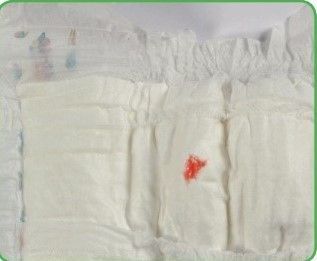
False menstruation or pseudo menstruation is harmless. It is a very light bleed from the vagina in some baby girls. It comes from the effects of your own hormones on her system, and it soon stops.
Nappy Wetness Indicator
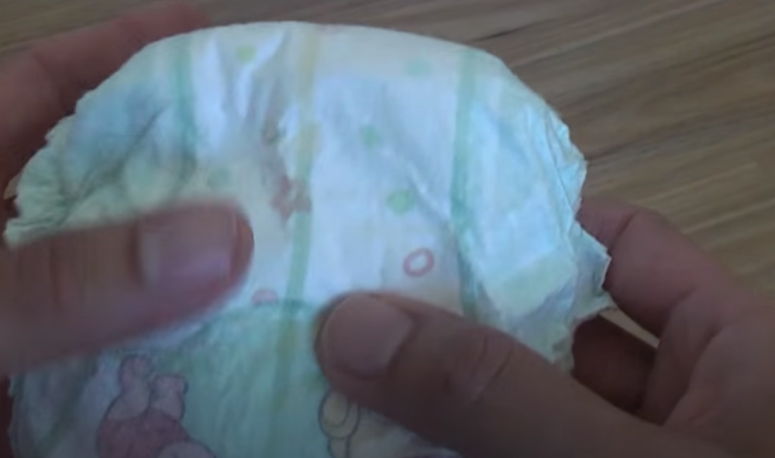
Some nappies include a line which indicates when the baby has passed urine. This can help parents to know how many wet nappies the baby has had.
Dirty Nappies
Dirty Nappy Day 0-1
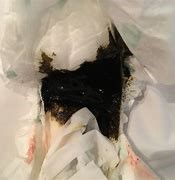
The first baby poo is thick and black/green and very sticky. There might be several nappies that look like this or just one or two.
Dirty Nappy Day 1-2
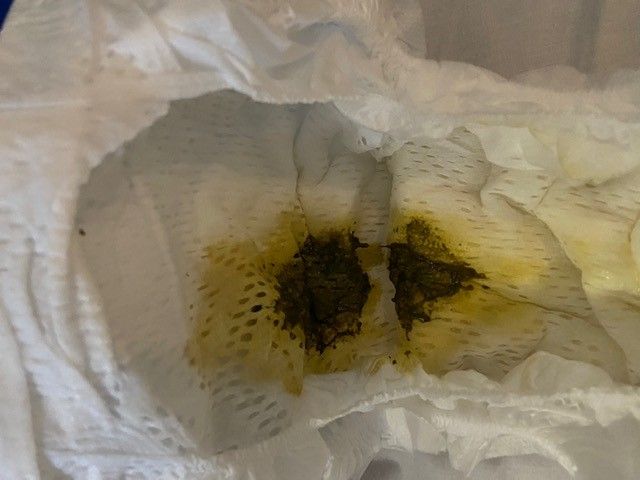
There will still be the black poo for a couple of day but it will start to get a bit more green and less thick.
Dirty Nappy Day 2-3
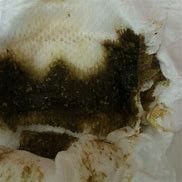
As the milk starts to travel through your baby's tummy you will start to see the poo change to a green/brown colour and it will start to have little bits that look like seeds in it.
Dirty Nappy Day 3-5
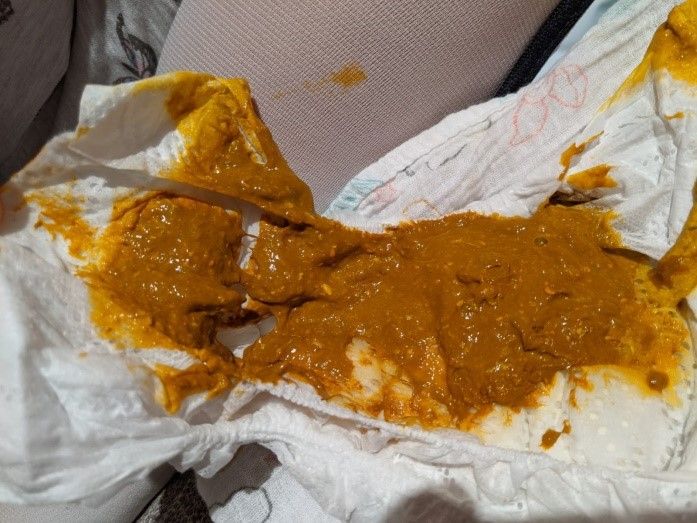
Once the baby is feeding more you will find the poo turns a brown colour and is quite loose. It will continue to have little bits in it that look like seeds and will have at least 2 dirty nappies a day
Dirty Nappy Day 7 onwards
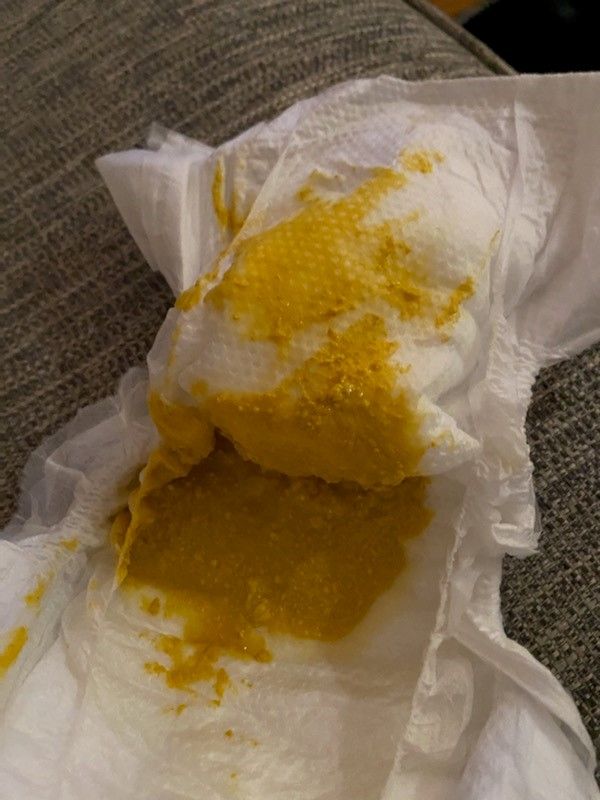
Exclusively breast fed baby. The poo will turn very yellow with small 'seedy' bits in it. It can be very watery which is normal. Some baby’s poo at every feed and some may go a few days without a dirty nappy. If your baby is feeding well and gaining weight then there is no cause for concern.
Formula milk fed babies. Some baby’s poo more often but usually once a day as a minimum. If your baby is feeding well and gaining weight then there is no cause for concern.
If your baby is struggling to have a poo and is constipated, please phone your Health Visitor for advice.
Further information on your baby's poo.
Further information on Nappy Rash.
Happy

Babies will normally have several wet nappies a day.
Some baby girls can have a small bleed or a discharge from their vagina. This is because of maternal hormones and usually only lasts a few days.
You may even notice a yellow or dark orange urine stain in the nappy. This is normal.
Not Sure

If you are worried that your baby has not passed much urine (wee) you should feed them frequently.
Put a little cotton wool in their nappy and you will know if they have passed urine.
Unhappy

From day 6 your baby should be having at least 6 heavy wet nappies in a 24 hour period. If you are concerned your baby is not passing enough urine (wee) contact your midwife, health visitor, the 111 service or your GP.
* The midwifery team will transfer care to the health visiting team within the first two weeks of your baby being born.
The contents of your baby’s nappy changes from day to day in the beginning. Breast fed babies often poo after every feed. You should expect:
- Day one to four: Baby’s nappies are usually black/green in colour. It can look like thick tar or marmite!
- Day four to seven: Your baby’s nappies will start to change colour from black/green to yellow.
- Day seven onwards. A baby’s nappy will be yellow. It will be soft and seedy if you are breastfeeding, or look like play dough if your baby is formula fed.
Wet nappies
The number of wet nappies you will expect to find changes in the first 7 days. Below is a guide to help you decide if your baby is passing enough urine (wee).
Day 1-2
2 or more wet nappies in the first 24 to 48 hours. The nappy will not feel heavy
You might see a small red/orange coloured mark in the nappy, urates, which should be smaller than a 5p piece
Day 3-4
3 or more wet nappies per day. The nappies start to feel heavier than before
Day 5-6
5 or more wet nappies per day. The nappy will feel heavy. If you want to check this then take a clean nappy and pour 3 tablespoons or 45mls of water into it. Pick it up, this is how a ‘heavy’ nappy should feel
Day 7 onwards
6 or more wet nappies per day
Urates

Urates are tiny orange or red crystals. They are harmless: they are salts in the urine, and tend to show up in the very early days.
Most babies will pass them once only. They can be a sign your baby needs a little help to feed more often or more effectively. Ask your midwife.
Pseudo Menses or False Periods

False menstruation or pseudo menstruation is harmless. It is a very light bleed from the vagina in some baby girls. It comes from the effects of your own hormones on her system, and it soon stops.
Nappy Wetness Indicator

Some nappies include a line which indicates when the baby has passed urine. This can help parents to know how many wet nappies the baby has had.
Dirty Nappies
Dirty Nappy Day 0-1

The first baby poo is thick and black/green and very sticky. There might be several nappies that look like this or just one or two.
Dirty Nappy Day 1-2

There will still be the black poo for a couple of day but it will start to get a bit more green and less thick.
Dirty Nappy Day 2-3

As the milk starts to travel through your baby's tummy you will start to see the poo change to a green/brown colour and it will start to have little bits that look like seeds in it.
Dirty Nappy Day 3-5

Once the baby is feeding more you will find the poo turns a brown colour and is quite loose. It will continue to have little bits in it that look like seeds and will have at least 2 dirty nappies a day
Dirty Nappy Day 7 onwards

Exclusively breast fed baby. The poo will turn very yellow with small 'seedy' bits in it. It can be very watery which is normal. Some baby’s poo at every feed and some may go a few days without a dirty nappy. If your baby is feeding well and gaining weight then there is no cause for concern.
Formula milk fed babies. Some baby’s poo more often but usually once a day as a minimum. If your baby is feeding well and gaining weight then there is no cause for concern.
If your baby is struggling to have a poo and is constipated, please phone your Health Visitor for advice.
Further information on your baby's poo.
Further information on Nappy Rash.
| Happy
|
Babies will normally have several wet nappies a day. Some baby girls can have a small bleed or a discharge from their vagina. This is because of maternal hormones and usually only lasts a few days. You may even notice a yellow or dark orange urine stain in the nappy. This is normal. |
| Not Sure
|
If you are worried that your baby has not passed much urine (wee) you should feed them frequently. Put a little cotton wool in their nappy and you will know if they have passed urine. |
| Unhappy
|
From day 6 your baby should be having at least 6 heavy wet nappies in a 24 hour period. If you are concerned your baby is not passing enough urine (wee) contact your midwife, health visitor, the 111 service or your GP. |
* The midwifery team will transfer care to the health visiting team within the first two weeks of your baby being born.
The umbilical cord will start to dry out and will usually fall off by the time your baby is two weeks old. The cord needs to be cleaned with cool boiled water and dried afterwards.
Please see video on how to care for your baby's cord.
Cord healing stages
Day 1-2 advice for parents
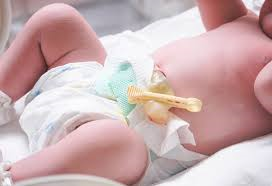
The cord will be quite thick and soft and will be held closed with a plastic clamp or peg.
Day 2-3 advice for parents
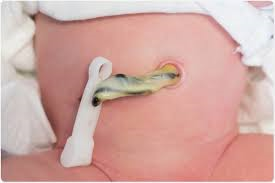
In the first two or three days the cord will get thinner looking and be hard and drier to the touch.
Day 3-5 advice for parents
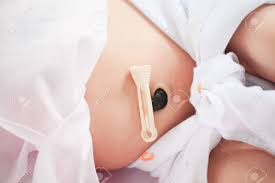
The cord will become very dark and hard in the first week.
Day 5+ advice for parents
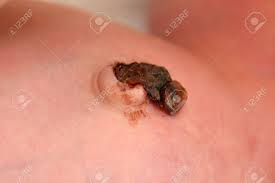
The cord may begin to ooze a little around where it joins onto baby's skin. This is when you can wash it off with water and dry it.
Do not be scared to gently move and clean underneath, it will not hurt your baby. Soon it will fall off, but never try to pull or pick it off.
When the cord falls off: day 5 to 14 advice for parents
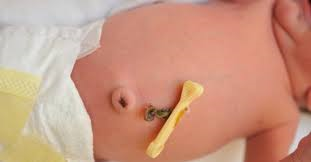
There will be a small 'scab' where the cord falls away from your baby's tummy. Just keep this clean and dry and over a period of time, new skin will develop. During this time there can be a little bit of old blood marking your baby's vest or clothes.
If your baby still has their cord attached after day 14 then contact your GP or Health Visitor for further advice.
Is my baby's cord infected?
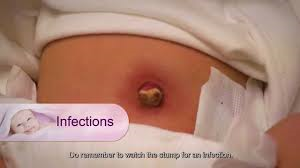
If the skin around the baby's cord looks red then it could be a sign of infection, particularly if the redness is above the cord in a line pointing towards the baby's chin.
Happy

The cord can be sticky underneath, this is normal.
There may be a spot of blood when the cord falls off. This is normal.
Unhappy

If you notice signs of infection, such as swelling, heat, redness and a smelly discharge contact your GP.
* The midwifery team will transfer care to the health visiting team within the first two weeks of your baby being born.
The umbilical cord will start to dry out and will usually fall off by the time your baby is two weeks old. The cord needs to be cleaned with cool boiled water and dried afterwards.
Please see video on how to care for your baby's cord.
Cord healing stages
Day 1-2 advice for parents

The cord will be quite thick and soft and will be held closed with a plastic clamp or peg.
Day 2-3 advice for parents

In the first two or three days the cord will get thinner looking and be hard and drier to the touch.
Day 3-5 advice for parents

The cord will become very dark and hard in the first week.
Day 5+ advice for parents

The cord may begin to ooze a little around where it joins onto baby's skin. This is when you can wash it off with water and dry it.
Do not be scared to gently move and clean underneath, it will not hurt your baby. Soon it will fall off, but never try to pull or pick it off.
When the cord falls off: day 5 to 14 advice for parents

There will be a small 'scab' where the cord falls away from your baby's tummy. Just keep this clean and dry and over a period of time, new skin will develop. During this time there can be a little bit of old blood marking your baby's vest or clothes.
If your baby still has their cord attached after day 14 then contact your GP or Health Visitor for further advice.
Is my baby's cord infected?

If the skin around the baby's cord looks red then it could be a sign of infection, particularly if the redness is above the cord in a line pointing towards the baby's chin.
Happy |
The cord can be sticky underneath, this is normal. There may be a spot of blood when the cord falls off. This is normal. |
Unhappy |
If you notice signs of infection, such as swelling, heat, redness and a smelly discharge contact your GP. |
* The midwifery team will transfer care to the health visiting team within the first two weeks of your baby being born.
It is normal for your baby to have dry skin. Your newborn baby may be born with a white coating known as vernix. This protects your baby's skin and will absorb naturally during the first week.
Flaking is also common and usually lasts 1 to 2 weeks.
Babies under 4 weeks should be bathed in water only. This does not need to be every day, every 2 to 3 days is enough. Do not add cleansers to your baby's bath water or use skin lotions or medicated wipes.
Not sure? If your baby's skin is very dry, speak to your health visitor or local community pharmacist.
Unhappy? If the skin is itchy, sore, uncomfortable or broken contact your health visitor, local community pharmacist or GP.
Please see below for a video on how to bath your baby.
Happy

Wash your baby with water. Avoid using cleansing products.
Not Sure

If your baby's skin is very dry ask your midwifery or health visiting* team for advice at your next appointment.
Unhappy

* The midwifery team will transfer care to the health visiting team within the first two weeks of your baby being born.
It is normal for your baby to have dry skin. Your newborn baby may be born with a white coating known as vernix. This protects your baby's skin and will absorb naturally during the first week.
Flaking is also common and usually lasts 1 to 2 weeks.
Babies under 4 weeks should be bathed in water only. This does not need to be every day, every 2 to 3 days is enough. Do not add cleansers to your baby's bath water or use skin lotions or medicated wipes.
Not sure? If your baby's skin is very dry, speak to your health visitor or local community pharmacist.
Unhappy? If the skin is itchy, sore, uncomfortable or broken contact your health visitor, local community pharmacist or GP.
Please see below for a video on how to bath your baby.
| Happy
|
Wash your baby with water. Avoid using cleansing products. |
| Not Sure
|
If your baby's skin is very dry ask your midwifery or health visiting* team for advice at your next appointment. |
| Unhappy
|
* The midwifery team will transfer care to the health visiting team within the first two weeks of your baby being born.
BABY BUDDY
Baby Buddy is your personal baby expert who will guide you through your pregnancy and the first six months of your baby’s life. It has been designed to help you give your baby the best start in life and support your health and wellbeing.
BABY BUDDY
Baby Buddy is your personal baby expert who will guide you through your pregnancy and the first six months of your baby’s life. It has been designed to help you give your baby the best start in life and support your health and wellbeing.
Midwives provide advice, care and support for women and their babies during pregnancy, labour and the early postnatal period. They provide health education and parenting advice until care is transferred to a health visitor. This usually happens when your baby is about 2 weeks old.
Sound Advice
A midwife is an expert in normal pregnancy and birth.
Midwives provide advice, care and support for women and their babies during pregnancy, labour and the early postnatal period. They provide health education and parenting advice until care is transferred to a health visitor. This usually happens when your baby is about 2 weeks old.
Sound Advice
A midwife is an expert in normal pregnancy and birth.
You can treat your child's very minor illnesses and injuries at home.
Some illnesses can be treated in your own home with support and advice from the services listed when required, using the recommended medicines and getting plenty of rest.
Sound advice
Children can recover from illness quickly but also can become more poorly quickly; it is important to seek further advice if a child's condition gets worse.
For information on common childhood illnesses go to What is wrong with my child?
You can treat your child's very minor illnesses and injuries at home.
Some illnesses can be treated in your own home with support and advice from the services listed when required, using the recommended medicines and getting plenty of rest.
Sound advice
Children can recover from illness quickly but also can become more poorly quickly; it is important to seek further advice if a child's condition gets worse.
For information on common childhood illnesses go to What is wrong with my child?
All community pharmacies across England are required to be Healthy Living Pharmacies. This means that they are able to offer advice on a range of healthy living matters which includes eating a healthy diet. They can provide information leaflets and give parents, carers and young people more information about other organisations that might also be able to help.
Pharmacists are experts in many aspects of healthcare, and can offer advice on a wide range of long-term conditions and common illnesses such as coughs, colds and stomach upsets. You don’t need an appointment, and many have private consultation areas. Your pharmacist will say if you need further medical attention.
Sound advice
- Visit a pharmacy if your child is ill, but does not need to see a GP.
- Remember that if your child's condition gets worse, you should seek further medical advice immediately.
- Help your child to understand. Watch this video with them about going to the pharmacy.
For information on common childhood illnesses go to What is wrong with my child?
All community pharmacies across England are required to be Healthy Living Pharmacies. This means that they are able to offer advice on a range of healthy living matters which includes eating a healthy diet. They can provide information leaflets and give parents, carers and young people more information about other organisations that might also be able to help.
Pharmacists are experts in many aspects of healthcare, and can offer advice on a wide range of long-term conditions and common illnesses such as coughs, colds and stomach upsets. You don’t need an appointment, and many have private consultation areas. Your pharmacist will say if you need further medical attention.
Sound advice
- Visit a pharmacy if your child is ill, but does not need to see a GP.
- Remember that if your child's condition gets worse, you should seek further medical advice immediately.
- Help your child to understand. Watch this video with them about going to the pharmacy.
For information on common childhood illnesses go to What is wrong with my child?
Health visitors are nurses or midwives who are passionate about promoting healthy lifestyles and preventing illness through the delivery of the Healthy Child Programme. They work with you through your pregnancy up until your child is ready to start school.
Health Visitors can also make referrals for you to other health professionals for example hearing or vision concerns, or to the Community Paediatricians, or the child and adolescent mental health services.
Contact your local Health Visiting Team:
Bradford Health Visitors or call - 01274 221223
Wakefield Health Visitors or call - 0300 373 0944
Craven Health Visitors or call - 01423 544265
Leeds Health Visitors or call - 0113 843 5683
Calderdale Health Visitors or call - 030 0304 5555 (local rate number)
Kirklees Health Visitors or call - 030 0304 5555 (local rate number)
Sound advice
Health visitors also provide advice, support and guidance in caring for your child, including:
- Breastfeeding, weaning and healthy eating
- Exercise, hygiene and safety
- Your child’s growth and development
- Emotional health and wellbeing, including postnatal depression
- Safety in the home
- Stopping smoking
- Contraception and sexual health
- Sleep and behaviour management (including temper tantrums!)
- Toilet training
- Minor illnesses
For more information about what Health Visitors do: What does a health visitor do?
Health visitors are nurses or midwives who are passionate about promoting healthy lifestyles and preventing illness through the delivery of the Healthy Child Programme. They work with you through your pregnancy up until your child is ready to start school.
Health Visitors can also make referrals for you to other health professionals for example hearing or vision concerns, or to the Community Paediatricians, or the child and adolescent mental health services.
Contact your local Health Visiting Team:
Bradford Health Visitors or call - 01274 221223
Wakefield Health Visitors or call - 0300 373 0944
Craven Health Visitors or call - 01423 544265
Leeds Health Visitors or call - 0113 843 5683
Calderdale Health Visitors or call - 030 0304 5555 (local rate number)
Kirklees Health Visitors or call - 030 0304 5555 (local rate number)
Sound advice
Health visitors also provide advice, support and guidance in caring for your child, including:
- Breastfeeding, weaning and healthy eating
- Exercise, hygiene and safety
- Your child’s growth and development
- Emotional health and wellbeing, including postnatal depression
- Safety in the home
- Stopping smoking
- Contraception and sexual health
- Sleep and behaviour management (including temper tantrums!)
- Toilet training
- Minor illnesses
For more information about what Health Visitors do: What does a health visitor do?
School nurses care for children and young people, aged 5 to19, and their families, to ensure their health needs are supported within their school and community. They work closely with education staff and other agencies to support parents, carers and the children and young people, with physical and, or emotional health needs.
Contacting the School Nurse
Primary and secondary schools have an allocated school nurse. Phone your child’s school to ask for the contact details of your named school nurse.
There is also a specialist nurse who works with families who choose to educate their children at home.
Contact your local school nursing team:
Bradford School Nurses 01274 221203
Wakefield School Nurses (0 to 19 service) 0300 373 0944 (local rate number)
Leeds School Nurses 0113 843 5683
Calderdale School Nurses 030 3330 9974 (local rate number)
Kirklees School Nurses 0300 304 5555 (local rate number)
Sound Advice
Before your child starts school your health visitor will meet with the school nursing team to transfer their care to the school nursing service. The school nursing team consists of a school nursing lead, specialist public health practitioners and school health staff nurses.
They all have a role in preventing disease and promoting health and wellbeing, by:
- encouraging healthier lifestyles
- offering immunisations
- giving information, advice and support to children, young people and their families
- supporting children with complex health needs
Each member of the team has links with many other professionals who also work with children including community paediatricians, child and adolescent mental health teams, health visitors and speech and language therapists. The school health nursing service also forms part of the multi-agency services for children, young people and families where there are child protection or safeguarding issues.
School nurses care for children and young people, aged 5 to19, and their families, to ensure their health needs are supported within their school and community. They work closely with education staff and other agencies to support parents, carers and the children and young people, with physical and, or emotional health needs.
Contacting the School Nurse
Primary and secondary schools have an allocated school nurse. Phone your child’s school to ask for the contact details of your named school nurse.
There is also a specialist nurse who works with families who choose to educate their children at home.
Contact your local school nursing team:
Bradford School Nurses 01274 221203
Wakefield School Nurses (0 to 19 service) 0300 373 0944 (local rate number)
Leeds School Nurses 0113 843 5683
Calderdale School Nurses 030 3330 9974 (local rate number)
Kirklees School Nurses 0300 304 5555 (local rate number)
Sound Advice
Before your child starts school your health visitor will meet with the school nursing team to transfer their care to the school nursing service. The school nursing team consists of a school nursing lead, specialist public health practitioners and school health staff nurses.
They all have a role in preventing disease and promoting health and wellbeing, by:
- encouraging healthier lifestyles
- offering immunisations
- giving information, advice and support to children, young people and their families
- supporting children with complex health needs
Each member of the team has links with many other professionals who also work with children including community paediatricians, child and adolescent mental health teams, health visitors and speech and language therapists. The school health nursing service also forms part of the multi-agency services for children, young people and families where there are child protection or safeguarding issues.
GPs assess, treat and manage a whole range of health problems. They also provide health education, give vaccinations and carry out simple surgical procedures. Your GP will arrange a referral to a hospital specialist should you need it.
All children should be registered with a GP. Anyone in England can register for free with a GP surgery. You do not need proof of address or immigration status, ID or an NHS number.
Sound advice
You have a choice of service:
- Doctors/GPs can treat many illnesses that do not warrant a visit to A&E.
- Help your child to understand. Watch this video with them about visiting the GP or going to a walk in centre
For information on common childhood illnesses go to What is wrong with my child?
GPs assess, treat and manage a whole range of health problems. They also provide health education, give vaccinations and carry out simple surgical procedures. Your GP will arrange a referral to a hospital specialist should you need it.
All children should be registered with a GP. Anyone in England can register for free with a GP surgery. You do not need proof of address or immigration status, ID or an NHS number.
Sound advice
You have a choice of service:
- Doctors/GPs can treat many illnesses that do not warrant a visit to A&E.
- Help your child to understand. Watch this video with them about visiting the GP or going to a walk in centre
For information on common childhood illnesses go to What is wrong with my child?
If you’re not sure which NHS service you need, call 111. An adviser will ask you questions to assess your symptoms and then give you the advice you need, or direct you straightaway to the best service for you in your area.
Please note, the online version of NHS 111 is only recommended for children over the age of 5. If your child is under 5 years old, please phone 111.
NHS 111 can also direct you to your nearest urgent treatment centre (minor injuries unit or walk-in centre).
Sound advice
Use NHS 111 if you are unsure what to do next, have any questions about a condition or treatment or require information about local health services.
For information on common childhood illnesses go to What is wrong with my child?
If you’re not sure which NHS service you need, call 111. An adviser will ask you questions to assess your symptoms and then give you the advice you need, or direct you straightaway to the best service for you in your area.
Please note, the online version of NHS 111 is only recommended for children over the age of 5. If your child is under 5 years old, please phone 111.
NHS 111 can also direct you to your nearest urgent treatment centre (minor injuries unit or walk-in centre).
Sound advice
Use NHS 111 if you are unsure what to do next, have any questions about a condition or treatment or require information about local health services.
For information on common childhood illnesses go to What is wrong with my child?
A&E departments provide vital care for life-threatening emergencies, such as:
- loss of consciousness
- breathing difficulties
- severe bleeding that cannot be stopped
- major trauma such as road traffic collisions
If you’re not sure it’s an emergency, call 111 for advice.
Sound advice
A&E departments provide vital care for life-threatening emergencies, such as:
- loss of consciousness
- breathing difficulties
- severe bleeding that cannot be stopped
- major trauma such as road traffic collisions
If you’re not sure it’s an emergency, call 111 for advice.
Sound advice
This guidance has been reviewed and adapted by healthcare professionals across West Yorkshire with consent from the Hampshire development groups.



